When I was in my early twenties I had a rabbit, a sixteen-pound French Lop that had free rein of parts of the house and succeeded in both equally fascinating and terrifying every houseguest I ever had. From her ability to clear a seven-foot gate to her skill in severing any cord or wire ever laid out in her path, Gwendolyn was much more akin to a troublesome toddler trapped in a four-legged body the size of a Corgi than what the average person pictures when they think of a pet rabbit.
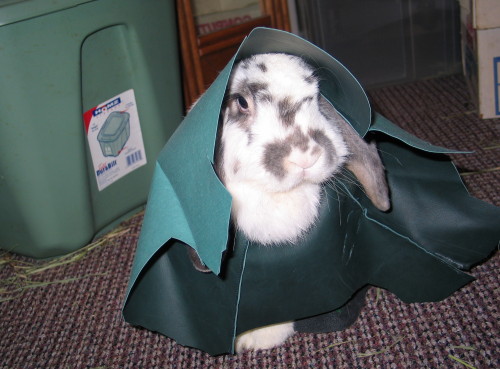
Gwendolyn, having busted her way through some vinyl. [A.Valkyrie]
Similarly to humans, rabbits have both quite the sweet tooth as well as a noted lack of self-control around what we would call ‘junk food.’ Carrots are the most popular example of this tendency, as rabbits crave them specifically due to their sweetness, but they will also obsessively seek out candy and other treats meant for humans, and will often make themselves sick if they gain access to an unattended stash of sweets. Animal trainers often take advantage of this tendency in rabbits by using papaya tablets as a reward, as rabbits are quick learners and will happily comply in exchange for the treat.
I did not know this when I called my vet about Gwendolyn’s digestive issues and she suggested giving her papaya tablets as a dietary aid. I bought a bottle of the tablets, shook it just for the sound and then opened the bottle in front of her and gave her a few, and put the bottle up on a shelf. A few hours later, I took the bottle off the shelf and shook it without really thinking, and she immediately came running at the sound. I gave her a few tablets, shook the bottle again, and she responded by jumping for the bottle. From that moment forth, every time I ever shook that bottle she immediately came running.
The association was advantageous in many ways. Any time I needed to find her, she would come immediately when I shook the bottle, which helped greatly at times for rabbits find great hiding spots. But over time I discovered that she responded in kind to the sound of any bottle, not just the papaya tablets, which is why over time everyone in the house took great care every time they opened a pill bottle. More than once, a guest opening an aspirin bottle in the bathroom was suddenly rushed by an enormous rabbit who would then occasionally jump at the exact source of the noise itself. This once resulted in a spilled bottle of aspirin and an immediately dangerous situation as the rabbit then desperately tried to eat the pills.
Its not that I hadn’t recognized the tendency in animals before. Nearly every house cat jumps at the sound of a can opening. But there was something about watching it click in the rabbit – the intensity and instantaneousness of the rabbit’s reaction, propelled by an addiction to sugar that I could clearly empathize with – that really opened my eyes to both the effectiveness and potentialities in how intelligent creatures of any persuasion can react to sound.
* * *
Two summers ago, I unexpectedly ended up with a sickly, four-week old kitten, having plucked her off the shoulder of a street kid after realizing that she would die without proper care. Although I wasn’t planning on adopting her when I first took her, I bonded closely with her as I nursed her back to health and after the first couple of days it was clear that she was my new cat.
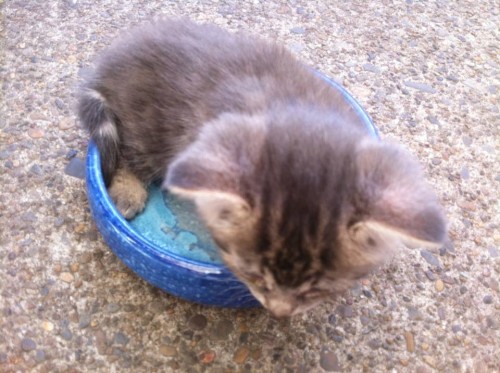
A very tiny kitten. [A.Valkyrie]
My living situation at the time didn’t allow me to leave a kitten at home unattended, so for the first month that I had her, the kitten I ended up naming Squirrel stayed on my body for the vast majority of any given chunk of day, usually either on my shoulder or in the hood of my sweatshirt. Our constant state of mobility made me quickly realize that I needed a way of immediately calling her back to me if she was to jump off my shoulder in a public place.
I thought back to my rabbit with the pill bottle, and then to the way that a cat responds to the sound of a can opening, and decided to integrate those examples with minor changes based on lessons from the past. I decided on a glass jar rather than a pill-bottle, hoping that the sound was distinct enough so that the kitten would not conflate a bottle of aspirin with cat food. I filled the jar halfway with dry kibble, and the next time I fed her I shook the jar before doing so. It took only a little more than a day for her to learn that the shaking sound meant food. A few days later, she jumped off my shoulder at a busy intersection in downtown Eugene, but only took two steps before being coaxed back by the shaking sound.
To this day, no matter where she is hiding, if I want her to come out all I have to do is shake the jar.
* * *
I tried forming relationships with crows when I first moved to Eugene with little success. They didn’t actively avoid or scorn me as I know they do to some, but they never seemed interested in my presence or my words. I didn’t push the relationship, especially considering that there were many other creatures and entities in that town that were actively seeking my time and attention.
In Portland, however, the crows have been a constant feature from the very beginning, living in great numbers both throughout downtown Portland in general as well as specifically in the area near Union Station where I live. They made their presence very obvious to me from the moment I started to move furniture into my building.
Time has also been a hovering constant from the very beginning. For the first time in my life, I found myself without a routine, without a reliable daily activity, without a proper or useful way to spend my time. Time is a reliable foe in that too much and too little can both effectively destabilize and eat at the soul, and in from moving to Eugene to Portland, literally overnight I went from a situation where I had absolutely no time to myself to a situation where I had more time than I knew what to do with. I had a bicycle, I had a fresh terrain to explore, I had ideas and thoughts and urges, and yet without direction, time still stood as a presence in a way I had never experienced before.
And while I know that the idea was seeded in my head by seeing the crows fly around the Union Station clock tower so often, crows and time became strongly and immediately linked in my mind. It’s a link that over the past year has become a self-fulfilling prophecy of sorts, as the presence and behavior of the crows eventually became my antidote to the ever-looming curse that time held over me.
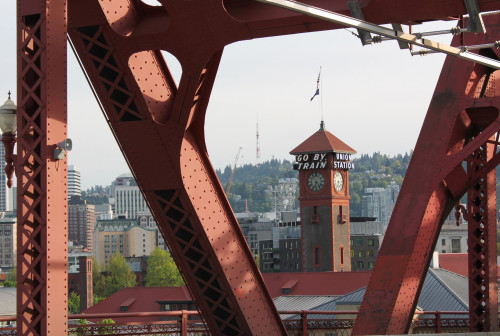
Clock tower at Union Station [A.Valkyrie]
* * *
I usually don’t remember my dreams, and I’ve learned from experience that if I am remembering my dreams, there’s something very important that I need to be paying attention to. Which is why a certain red flag went up once I started dreaming of crows for several nights in a row.
After the third or fourth night, I woke up at the crack of dawn, trembling, the images of crows seemingly seared into the darkness behind my vision. Without really consciously understanding what I was doing, I quickly threw on some clothes and stumbled down to the riverbank, seeking out a familiar dark and still spot on the water. Still half-asleep, still seeing crows when I closed my eyes, I stared into the water and briefly fell into a trance. The crows that were burned into the darkness of my vision were suddenly reflected in the water, appearing larger than life. I looked up and noticed that two actual crows were circling. They flew down at me, almost touching the riverbank, and then took off towards the west.
I followed them for as long as I could keep track of them. They led me throughout Northwest Portland, touching down repeatedly at corners and intersections that I tried desperately to mentally note while also desperately trying to keep up with the flying pair. I finally lost sight of them underneath the 405, and yet as I was headed back home I could hear them nearby and I had the distinctive feeling that I was being watched.
That night my dreams felt like a trap, a pull, a call, a maze of repeated imagery in which crows shifted into a dark-clad woman, who then shifted back into a crow. I recognized her immediately; we had been chatting on and off for years with no serious commitments on either side. And yet it was still all rather vague. I woke up not sure how to proceed. There were still too many pieces missing.
A few days later, when Rhyd Wildermuth posted a blog about bees and bestowing kindnesses towards ravens, I knew better than to shrug it off as mere coincidence. I made a mental note to buy a container of unsalted peanuts the next time I was out and to keep an eye out for crows.
And then a few days after the blog post as well as another series of crow dreams, my partner and I were on our walking down First Avenue just north of the Burnside Bridge, only a few feet away from edge of the buildings, when I noticed a crow standing still in the corner by a window. Thinking he was hurt, I approached the crow slowly and stooped down. The crow stared me right in the eye, less than two feet away, and immediately I could tell he was not actually hurt at all.
“What’s up? Are you OK?” I asked the crow, and suddenly I was flooded with a stream of thoughts and visions… from Rhyd’s blog about feeding ravens, to the crow dreams I had, to the crows on the riverbank the other day…and then thoughts and images of my old rabbit Gwendolyn and the papaya bottle, and of Squirrel and her glass jar of cat food, of myself on my bike riding through downtown, and then of peanuts and more crows. Suddenly, it all clicked.
I had meant to buy peanuts. I looked at the crow, feeling terrible that I had nothing to give to it at the moment. I thanked the crow for the information and apologized for my lack of a treat. I wouldn’t make such a mistake again, I said to myself.
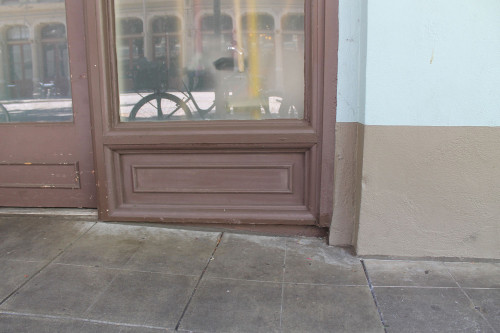
Under the bridge, where I met the crow [A. Valkyrie]
I looked at my partner. “I think I get it now, I think I finally get it,” I said. “I’m supposed to be watching the crows, making friends with the crows. Like as a regular thing, a daily thing. I think that’s what I’m supposed to be doing with my time right now. ”
He looked at me and nodded. “That makes sense,” he said.
* * *
Once you train your eye to notice specific features within the landscape, it’s often impossible to un-see them. The feature becomes encoded in both one’s conscious awareness as well as the subconscious, and creates a hiccup in one’s latent inhibition, unwillingly interrupting any given moment of observation in order to announce its presence. This tendency is why many graphic designers can’t help but to constantly complain about fonts, or architects about the eaves or arches of any given building. The graphic designer can’t not notice the painful use of Papyrus in the storefront sign, nor can the architect not notice the cheap and brutal travesties that are de rigueur in modern design.
This same tendency comes forth pretty quickly when one consciously decides to notice and acknowledge every crow that they come across. I poured some peanuts into a plastic box with a lid and started setting out daily, following the crows while shaking the box to announce my presence and feeding them whenever I got their attention. I was trying to attune myself to their perspective while at the same time paying close attention to what is taking place in my own world as well.
And within the space of a few weeks, I realized that I couldn’t not see a crow, I couldn’t ignore a crow, I couldn’t relegate a crow to a feature of the landscape anymore no matter how hard I tried. I’m not sure how long the sound of a crow prompted an immediate reaction in me before I consciously noticed that it was happening – but I know now that I can’t tune it out any more than a mother can initially tune out the cry of her baby. Every time I saw a crow fly above me, I couldn’t not look up. Riding my bike in downtown traffic presented a bit of a challenge.
Unlike fonts and arches, however, what’s different about attuning oneself to noticing crows is that the gesture is reciprocated, especially when you offer them treats. The crows start to notice you as well and, even in a dense urban area such as downtown Portland, one quickly starts to realize that they’re always being watched to an extent. I may be constantly looking for crows, but I also get the strong sense that they don’t have to look for me. They know where I am as soon I leave my building. They know where I am even when I have no idea where I actually am.
The more I think about the vastness of a crows-eye view, the more I start to think that the crows know this city much better than any of its citizens ever possibly could.
* * *
It also didn’t take me long to realize that the pigeon-crow relationship dynamics are at least as interesting and complex as most of the human relationship dynamics that I observe while downtown. Other than Canadian geese on the waterfront, crows and pigeons are the only two sizeable birds that inhabit downtown Portland, and they are constantly interacting with each other on nearly every corner or rooftop.
The differences in their pack habits and their mannerisms stood out immediately. Rarely do I see a solo pigeon, and rarely do I not see a solo crow. Pigeons generally go about their business in flocks on the ground, while crows often fly in pairs or trios. When foraging for food, they are usually on their own. The pigeons are braver and much pushier in seeking out food in the presence of humans, but not nearly as observant or sensitive to the subtle goings-on, as the crows are. A crow will spot a hipster discarding a sandwich from half a block away, while the pigeons often miss bread that tourists throw directly at them. The more populated the area, the more the crows hide in plain site while the pigeons bobble in a flock in the middle of the commotion. On the food cart blocks in downtown Portland, one practically trips over the pigeons in their path while the crows watch from the light-posts, unnoticed for the most part.
And yet despite their shyness and altogether lack of aggressiveness when compared to the pigeons, a single crow will fend off a whole flock of them in defense of his claimed prize, using a wide assortment of noises, dances, and aggressive gestures in order to chase the intruding birds away. On the campus of Portland State University, I watched a crow aggressively fight off pigeons for several minutes in order to defend a half-eaten burrito in the bottom of a take-out container that the crow had dragged out of an overflowing trashcan. At one point, the crow grabbed the fork out of the container with his beak and threw it towards the pigeons. After the flock finally left, the crow carefully and expertly tore the excessive pieces of tortilla off the side of the burrito before taking the remainder of it in his beak and flying off to a nearby rooftop.
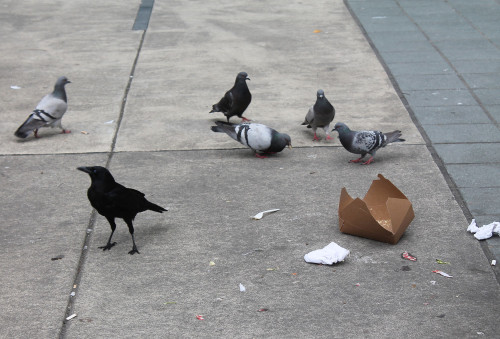
Crow standing off against pigeons [A. Valkyrie]
“What you got against pigeons?” he asked me.
“Nothing, really. I’m just more interested in the crows, that’s all.”
“What, you think crows are better than pigeons?”
“No, it’s not a contest, but I’ve been working with crows, not the pigeons. Its nothing against the pigeons, I’m just not seeking them out.”
He seemed intent on challenging that. “Don’t you think that’s a little unfair?”
I took a deep breath. “Look. I’m not in the mood for an argument about bird rights and bird equality, OK? If you think I’m being unfair to the pigeons, give them a little attention yourself. There’s nothing personal here. I just work with crows.”
He gave me a dirty look and walked off, himself shooing away the pigeons as he left. I was reminded that within a downtown urban landscape, even the subtlest of solitary activities are not really solitary. One always has an audience.
On my way home I took a longer route, up and around through the Pearl District. As I was riding through, it occurred to me that I rarely ever see a single crow north of Glisan Street, in the newer part of the Pearl. I thought about what I found distasteful about the neighborhood – not enough trees, too many boxy buildings, way too much construction, too many dogs, and very few places to deposit trash – and I laughed out loud, realizing that the crows most likely avoided the Pearl for the exact same reasons.
* * *
I feel like a Pied Piper of sorts, riding through the streets of downtown Portland every day around lunchtime, shaking the peanut box as I ride past corners where I know crows to congregate. After a few months, I find myself in a steady routine along a specified path throughout downtown, a path that was overall dictated by the crows themselves. What first started as simply following their caws quickly turned into a dedicated route with expected interactions on both sides, often taking several hours out of my day. I approach the location, shaking the peanut box, and more often than not a crow appears a short time later. I then toss some peanuts, back up a bit, and the crow usually advances and starts to snack.
I quickly find that there are subtle maneuvers and tendencies that make a world of difference. Tossing peanuts underhand is best – overhand startles the crows and they often fly away. They don’t appreciate my sunglasses much, nor the squeakiness of my rear brakes. But they very much like being talked to, and they make quite the show of knowing that they have your attention.
Without deliberately meaning to do so, I realized that I’ve started to give the crows nicknames in my mind based on the locations in which I tend to find them.
The “Bud Clark crows” hang out in the trees across the street from Bud Clark Commons, a “Housing First” shelter and homeless day center that sits a block from Union Station. The Bud Clark crows are noticeably both louder and braver than any of the other crows that I come upon regularly. I can’t help but to think that this is a very specific co-adaptation to their specific location, as the folks who regularly hang out on this block themselves tend to be noticeably louder and braver than what one would generally expect in this neighborhood. The crows have adapted to other the rhythms of the local residents, swooping in daily around the same time just after lunch to pick up the food scraps from the patio and the surrounding sidewalk.
The “yoga crows” are a bonded pair who live on the rooftop next door to a yoga studio a few blocks north of Burnside. At least one of them spends nearly every day perched above the studio, watching the action below while scolding and mocking random passers-by.
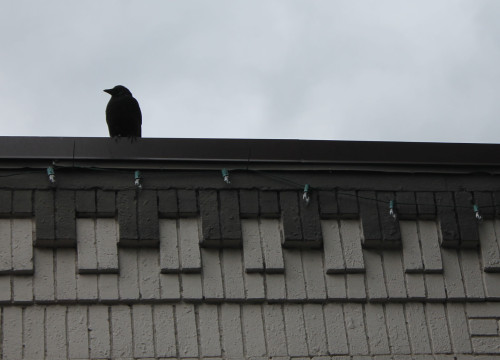
Yoga crow, watching from above [A. Valkyrie]
He was obviously showing off, and I was quite impressed.
The “parking lot crow” often acts as a supplemental security guard for a parking lot on an unusually deserted and empty block in Old Town. This crow paces back and forth at the entrance, warily observing the pigeons while keeping an eye peeled for any scraps that the flock may come across. When the actual security guard steps onto the property, the crow often jumps on the cars, hopping from rooftop to rooftop while cawing in a mocking tone. The parking lot crow was the very first to start to respond to my shaking the peanut box, and is the least timid of all the crows that I regularly interact with.
A few blocks from the parking lot crows are the “ODOT crows,” who hang out in the trees around the employee headquarters for the Oregon Department of Transportation. They scavenge for scraps dropped by employees on their cigarette breaks, and they frequently take over the parking lot once everyone has left for the day. Recently, one of the ODOT crows has taken to swooping above my car when I drive past the building, and he’s not the only crow to start flying past my car as I drive through the neighborhood.
When I go by the ODOT building at other times separate from my crow route, I often see one of two crows in the side-street, comically dancing and waving around twigs or food scraps while a passer-by stands and watches in amusement.
And if I shake my peanut box, they usually pause and look right over at me.
* * *
I had noticed the man watching me from the roof of the homeless shelter almost daily as I interacted with the parking lot crow. This time, he was standing in the middle of the parking lot as I approached on my bike, shaking the peanut box towards the parking lot crow who was perched on the pole. He watched us for a few minutes, and once the crow had his fill of peanuts and flew off, he approached me.
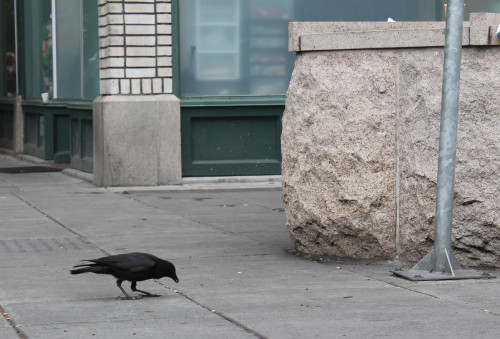
The parking lot crow
“Why are you feeding the crows?” he asked me.
I looked at him for a moment and decided to tell him the simplest version of the truth.
“Because a rather intimidating deity-type who came to me in my dreams asked me to and I couldn’t really say no, and I also really needed something to get me out of the house. I’m still don’t have a solid grasp on the entirety of the why part yet, but its making more and more sense by the day, I’ll tell you that.”
“Can you really make friends with crows? Why do you shake that box for?”
“If you want to make friends with them, just feed them. And talk to them. And be nice to them, and calm. They shy away from loud noises and yelling. They will learn to remember you quickly, and they will trust you the more you show kindness. I started shaking the peanut box with the idea that they would learn to respond to the sound, expecting a treat. At this point I’m pretty damn sure that it works.”
“Huh…” he said, his voice drifting off a bit.
I looked at him for a moment, handed him my peanut box, and pointed towards the crow. “Here, take this,” I said. “The crow expects me in the afternoon. I’ll bet you that if you start coming down here in the mornings, shaking the box, and scattering some peanuts, you’ll have a crow friend by the end of the week.”
I smiled at him and then started to ride off the long way towards my building. A block away, a crow flew above me and landed in the street ten feet or so ahead of me. The crow looked at me expectantly.
I pointed back toward the man from the shelter. “I gave him my peanut box, man,” I said. “You gotta go ask him. I’m going home to put together another one.”
I doubt the crow actually understood what I had said, but nevertheless I watched him look over and then fly to the pole at the edge of the parking lot. I shook my head, amazed at how vastly my perception of this city has shifted over four months’ worth of paying attention to crows, and I continued on my way home.
* * *
This column was made possible by the generous underwriting donation from Hecate Demeter, writer, ecofeminist, witch and Priestess of the Great Mother Earth.
The Wild Hunt is not responsible for links to external content.
To join a conversation on this post:
Visit our The Wild Hunt subreddit! Point your favorite browser to https://www.reddit.com/r/The_Wild_Hunt_News/, then click “JOIN”. Make sure to click the bell, too, to be notified of new articles posted to our subreddit.
Loved it. And the column reminded me of something in Gary Snyder’s essay “The Etiquette of Freedom”: “The world is watching: one cannot walk through a meadow or a forest [or the Portland park blocks] without a ripple of reports spreading out from one’s passage.”
We are like crows in this city. Like them, we evolved over millions of years toward a particular type of habitat–open, unfettered, dangerous. Sort of like our cities, but without air conditioning, and a lot quieter. We certainly didn’t evolve with big boxy buildings, noisy roads, and blaring billboards all around us, and neither did the crows.
Civilization has had a learning curve for all of us, humans and crows and elk and tigers alike. The first two have adapted much better than the last two, but there are still effects. Most notably, humans have convinced themselves (ourselves?) that we’re no longer part of ecosystems, that we stand alone. Your time with the crows reminds us that the truth is just the opposite. It’s a much more meager ecosystem with a lot less species diversity, but it’s there, glowing faintly in a web of lines connecting us.
Thank you for the reminder that that still exists.
Thanks for this great article. Crows are amazing creatures, aren’t they? I have begun developing a relationship with the crows who live in my neighborhood. I put out unsalted peanuts for them outside my house every morning. For the blue jays as well. But the crows are my favorites. They are such intense birds. 🙂 I was thinking about them, and the Morrigan this morning, and lo and behold, there is a link to your article through the WildHunt feed on my page. 🙂
Within a few dozen generations, I suspect tales of the mysterious crow-shaman edgewalkers will be told, and children will learn to fear the ominous death-rattle percussive shake of their magic peanut crow summoner amulets.
Thank you for this great story.
I love it when Pagans pay attention to the actual animals we share our lives with, not just idealized notions of animals we pick up from card decks and the Internet.
Crows are less glamorous than their bigger cousins, ravens, I suppose, but I don’t know if I’ve ever seen a raven; they were hunted so aggressively in New England at one time they pretty much disappeared, and their evolutionary niche seems to have been taken over by crows.
They have a lot in common, of course: the high intelligence, the ability to recognize individual human beings, and to approve or disapprove of us as individuals, too.
Have you encountered the book Ravens in Winter, by Bernd Heinrich? I wonder if you would find it as fascinating as I have…
http://www.goodreads.com/book/show/122665.Ravens_in_Winter
Ravens have been expanding their range in the San Francisco Bay Area over the past few decades, and are now a common sight in forested areas. They aren’t seen much in cities around here.
Wonderful story. Do you use shelled or unshelled peanuts? My blue jays love them in the shell, ignore them otherwise.
Rhyd said that they prefer them in shells, as they can take them away to store instead of eating them then and there. I suppose they’d be happy for either, just the same.
I started with unshelled because I wanted a certain percussive sound in my peanut box. But they can definitely see the shelled ones much better.
A very very interesting read.
In our Campbell neighborhood, I noticed that once the crows moved in, we saw fewer of other birds.
Now if the crows would only chase away the Canada geese that have decided to move in and NOT migrate….
Hmmm…interesting. I work as a therapist and herbalist out in the Montavilla neighborhood of Portland. I built a backyard office that I call the “Crow’s Nest” as I have a special affinity for this sly, smart creature. Crows seem to fly directly over my office at sunset towards the West and the river- and then fly back over it to the East at Sunrise. I assume they have different sleeping and roaming grounds. Probably 500 crows fly like this every day- a real clan. Thanks for this fascinating article…